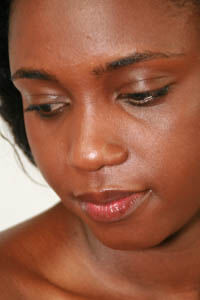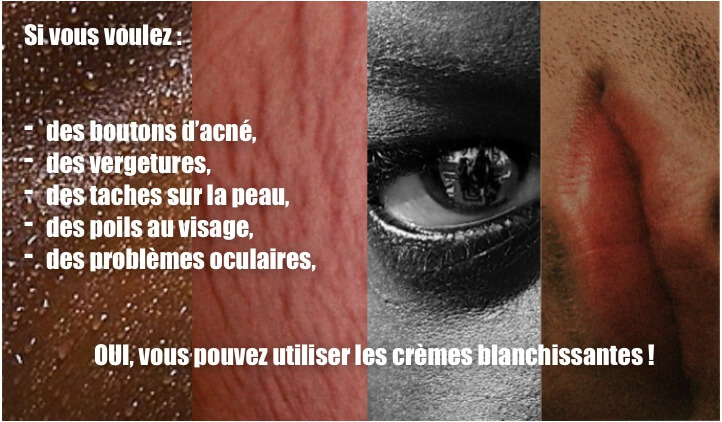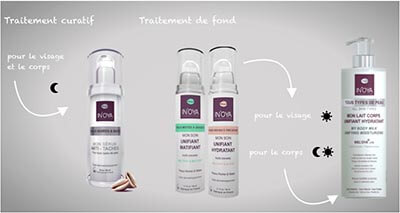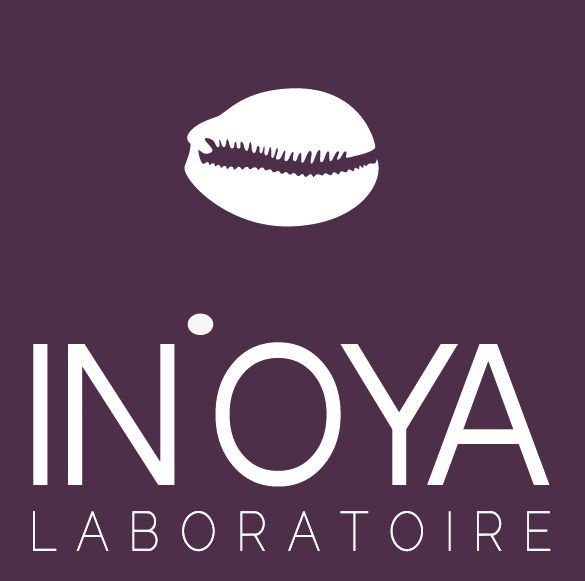Lightening products: consequences and alternatives
 You may know it as "xeesal", "leeral", "akonti", "ambi", "tcha", or "bojou". Voluntary depigmentation corresponds to the cosmetic use of depigmenting products to lighten the skin for an "aesthetic " purpose. This phenomenon is still today a reality, often unconfessed.
You may know it as "xeesal", "leeral", "akonti", "ambi", "tcha", or "bojou". Voluntary depigmentation corresponds to the cosmetic use of depigmenting products to lighten the skin for an "aesthetic " purpose. This phenomenon is still today a reality, often unconfessed.
Whether natural or synthetic, these products can be harmful to human health. Among the most dangerous, hydroquinone and corticosteroids are on the first two steps of the podium. Mainly available for medical purposes for skin pathologies, these two assets can be the subject of an illicit parallel market. Worse still, they can be hidden from the user in cosmetic products that do not comply with current regulatory standards. It also sometimes happens that the concentration of the active ingredient indicated on the packaging is deliberately falsified.
For example, an analysis campaign conducted in 2006 on 60 cosmetic products marketed in African shops and hair salons in Switzerland revealed that 75% were non-compliant due to the presence of prohibited substances or exceeding the maximum level established by the legislation in force. In addition, in 2009 and 2010, Afssaps and DGCCRF carried out a national campaign to monitor the market for depigmenting products. The analyses were carried out on more than 160 products and revealed about 30% in 2009 and 40% in 2010 of products that do not comply with the regulations of cosmetic products and dangerous to health due to the presence of prohibited substances (mainly hydroquinone and corticosteroids).
What are the dangers of whitening creams?
The side effects related to the use of these active ingredients are mostly skin-like. Often the depigmentation is non-uniform, and the skin color is yellowish. When used on large areas, especially in wet conditions, there is a risk of systemic effects due to greater absorption of assets. In the long run, these effects can have serious repercussions on human health and even lead to premature death.
Let's see in detail the specific complications of depigmenting active ingredients...

Depigmenting active ingredients can cause acne pimples, stretch marks, black spots, facial hair, eye problems, etc.
Depigmenting active ingredients banned in Europe in cosmetic products
Hydroquinone : hydroquinone, mequinol
Corticosteroid : clobetasol propionate, betamethasone dipropionate, betamethasone valerate, hydrocortisone aceponate, difluprednate, fluticasone, desonide, hydrocortisone butyrate, diflucortolone valerate, amcinonide, fluocinolone acetonide, fluocortolone, hydrocortisone
Mercurial derivative : mercuric chloride, mercurous chloride, mercury oxide, mercury chloramidide, ethylmercury sodium thiosalicylate (thiomersal), propionate phenylmercury
Retinoid : adapalene, isotretinoin, tretitinoin
How to recognize a lightening cream?
Hydroquinone
|
Skin Periorbital hyperchromia " in glasses ", which is hyperpigmentation around the eyes is one of the most frequent manifestations. During prolonged use, the paradoxical appearance of hyperpigmentation can also be observed in areas exposed to the sun. Known as exogenous ochronosis, this pigment disorder makes the skin rough and thick. It can also be associated with a blue-gray pigmentation of the pinna of the ear. The appearance of large so-called " nodular" pimples is also observed in many cases. In addition, hydroquinone is toxic to the cell and leads to the death of melanocytes. Collagen fibers lose their elasticity which gives the skin a " wrinkled " appearance and leads to poor healing. |
 |
Systemic
At the ocular level, cases of cataracts have been recorded.
Skin cancer risks are suspected.
Pregnancy and lactation
Hydroquinone is suspected of being mutagenic (i.e. it could cause changes in DNA that cause cancer to develop).
Corticosteroids
|
Skin Corticosteroids decrease the immune system, which helps protect us against different infections. Thus, the skin is much more vulnerable to microbiological aggressions. The risk of fungal, bacterial or viral infections is increased and their virulence increased. In addition, the application of corticosteroids weakens the skin: it is common to note the appearance of large stretch marks and skin thinning, revealing the vascular network, and causing poor healing.
Other skin side effects may also appear: - pustular acne - contact eczema - hyperpilosity - plate of pimples around the mouth - very light, red and weakened eyelids |
.jpg) |
Systemic
Beyond these skin effects, systemic effects can also add up if the use is prolonged.
A hormonal disorder, called Cushing's syndrome, is observed by chronic obesity of the upper body and a swollen facies. This hormonal deregulation can also manifest itself in irregular menstruation.
High blood pressure, diabetes and bone weakening are also the result of intensive application of corticosteroids.
At the ophthalmic level, there are risks of glaucoma and cataracts.
Pregnancy and lactation
The risk of fetal and obstetric complications is evoked, especially with a low birth weight and a predisposition for the child to develop cardiovascular, metabolic or neuroendocrine disorders. Also, a risk of poor healing of caesarean section in the mother is also mentioned.
Mercury derivatives
Skin
Allergies are the most common skin manifestations. The deposition of mercury in keratin also leads to discoloration and fragility of the nails. In the long run, they cause paradoxical hyperpigmentation due to the accumulation of mercury in the dermis.
Systemic
The main damage is at the renal level, leading to a risk of end-stage renal failure. A neurotoxic effect could also be observed.
Pregnancy and lactation
Mercury derivatives can slow the brain development of the fetus and infant causing risks of poisoning in the newborn.
Note: Only ethylmercury sodium (thiomersal) and phenylmercury are authorized as preservatives at a concentration not exceeding 0.007% mercury (bacteriostatic properties).
Retinoids (vitamin A acid derivatives)
The main side effects found with retinoids are located on the skin:
- burns
- Tingling
- erryth̀me
- dryness
- Peeling
Depigmenting assets allowed but to be used with caution
Azelaic acid: itching, burning, pain, dryness
Glycolic acid : risk of hyperpigmentation in dark skin, burns, dryness
Arbutin : risk of melanotoxicity by a rapid transformation into hydroquinone in the body
Kojic acid : risk of allergies and severe irritations: restrictions on use on damaged skin and on large areas of skin
Conduct to be taken and the solutions of the IN'OYA Laboratory
Of course, it is important to carry out an immediate discontinuation of suspected products with the exception of corticosteroids where the discontinuation will have to be gradual (due to corticodependence). The doctor will also often lead at first to prescribe corticosteroids of lower intensity.
If one or more symptoms, skin or general, mentioned above is noted; medical advice is strongly advised.
In any case, strict sun protection should be performed every day as the skin is damaged by lightening cosmetics and the sun may aggravate the lesions. My Sun Fluid SPF 50 SUN'OYA® allows an optimal protection guaranteed 0% of white traces even on the darkest skin.
It is also essential to avoid friction that leads to weakening of the skin.
To solve the problems of spots due to depigmentation, the IN'OYA laboratory has developed a tailor-made range for black, matte and mixed skin.
A future without stains: MEL'OYA® range
The flagship product, My MEL'OYA® " anti-stain " serum, regulates the synthesis of melanin pigments, which cause the brown color of the skin, and activates cell renewal. In 28 days, the spots are visibly attenuated and the complexion unified. The other products in the range: day care and body milk make it possible to perpetuate the action of the serum. They are to be used in addition during a treatment cure and to be used alone to prevent the appearance of new spots.
The entire IN'OYA Laboratory team is at your disposal to accompany you and advise you on a personalized care protocol. Do not hesitate to contact our customer service on +33 (0)4 42 90 72 28 or by email contact@inoya-laboratoire.com



